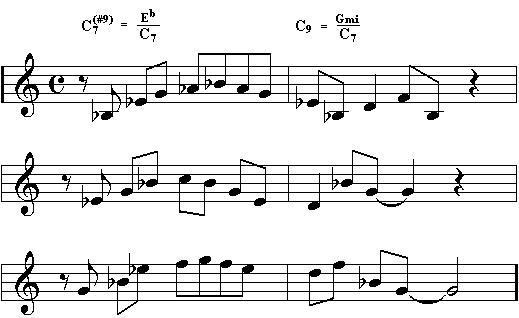Second Single Alteration: Dominant Sharp 9
We will discuss 3 ways for soloing over a dominant sharp 9 chord:
1) From the bitonal triad.
2) From a minor scale.
3) From a diminished scale.
FROM THE BITONAL TRIAD
Here is the most common voicing for a dominant sharp 9 chord on the guitar with the 2 positions possible. The bitonal triad is E flat. Technically, it’s D sharp since the 9th of C is D - hence the sharp 9 would be D sharp. However, most musicians of any instrument other than guitar generally think in flat keys rather than sharp keys. So the common bitonal spelling is Eb over C7 (Eb/C7).

The E flat triad is easily seen on the top of the chord in either position. There are many other voicings/positions for a dominant sharp 9, of course (See Unit 7 of my book, Vertical Truth - Chordal Mechanisms for the Guitar ). But these are the ones from which the upper triad is most easily visualized.
So...our melodic phrases over C7(b9) will be based on E flat major triad arpeggios.
Here's an example that adds the 2nd to the E flat major:

This next one adds a 4th to the E flat major in the first bar, a 4th and a 2nd in the second bar, and a 4th in the third bar:

Here's an Allman Brothers-esq phrase. However, as far as I know, the Allman Brothers never got into bitonalism. They would have used this melody over an E flat major tonality as opposed to a C dominant tonality as it is used here:

Many times an altered chord will resolve to the unaltered chord. The melody can reflect this. Here is a common device: the C7(#9) chord resolves to the unaltered C9. This results in the bitonal triad going from E flat to G minor.

II - V - I EXAMPLES
Example 1:
Over the II chord I'm thinking a D-7 arpeggio. Over the V chord I'm thinking Bb Major Pentatonic - Bb major is the bitonal triad of G7(#9). Over the I chord I'm thinking
E minor, which is the upper extension triad of Cmaj7.

Example 2:
Over the II chord I'm thinking D Minor Pentatonic. Over the V chord I'm thinking Bb major, which is the bitonal triad of G7(#9). Over the I is a Cmaj7 arpeggio with a 4th added.

FROM A MINOR SCALE
By far the most common way to solo over C7(#9) is to simply play in C minor. This works because the sharp 9 is the octave of the minor third. Below is another phrase that I consider to be a C Minor Pentatonic Scale with a bunch of passing tones thrown in. Notice that in the last bar, beat two, I use both the minor 3rd (which states the sharp 9) and the major third (states the third of the C7).

Here's a V to I situation - C7(#9) to Fmaj7. Over the C7(#9) I'm thinking in terms of C minor. Over the Fmaj7 I'm thinking in terms of A minor, which is the upper extension triad.

FROM A DIMINISHED SCALE
In the same way that a diminished tonality is used based on the 3rd, 5th, 7th, or flat 9th of the dominant flat 9 chord, the same is true for a dominant sharp 9 chord. This is because said diminished scale includes both the flat 9 and the sharp 9 of the chord. For example:

An E diminished 7 arpeggio could also be used, but is not as explicit because the arpeggio does not include the sharp 9, only the flat 9.
Having said that, here's a phrase that's based on an E diminished 7 arpeggio. However, the saving grace is that the last note of the phrase is the sharp 9 (E flat).

Here is an example that combines a diminished concept (based on the 7th of C7) and the bitonal triad (Eb).



